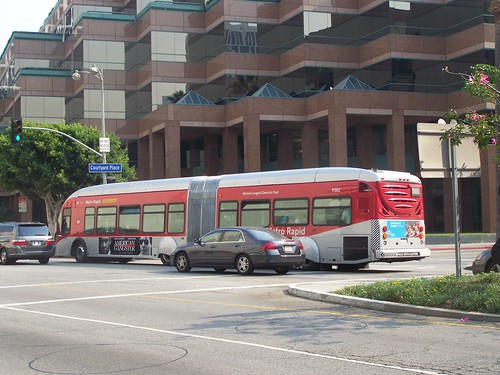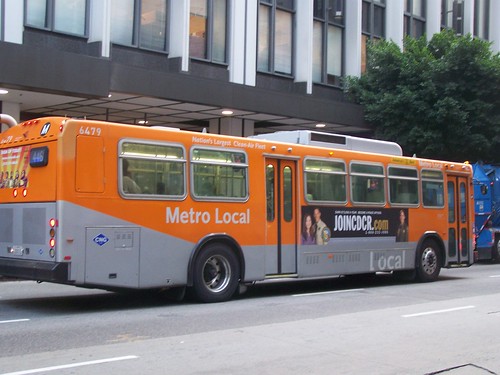Prioritizing sustainable mobility in Toronto, Chicago, and Los Angeles
Nationally, transit ridership is down--although problems with transit service in New York City are a result of very large increases in ridership ("Surge in Ridership Pushes New York Subway to Limit," New York Times). This is attributed to cheap gasoline prices, some service cuts by transit agencies in response to budget problems, and the rise of ride hailing services ("Ride-Sharing Decreases Public TransitUse," Government Technology).
Chicago. Earlier in the week, Chicago's Active Transportation Alliance released a report, Back on the Bus: Speeding Up Chicago's Buses, about ways to improve bus ridership, which as in many cities across the country, has been dropping ("As buses slow and ridership sinks, advocates look for ways to lure commuters back," Chicago Tribune).
The report makes a number of recommendations on service improvements--nothing about fares--to speed throughput, as most research demonstrates that the time spent traveling is the main decision point concerning mode choice, along with cost.
• Dedicated bus lanes – Create a network of Transit Priority Streets, as outlined in the Chicago’s Complete Streets policy, including at least 50 miles of dedicated bus lanes and other on-street infrastructure to give crowded buses priority;
• Traffic signal improvements – Move buses more smoothly through busy intersections by changing signal timing or using technology that gives buses an extended green light to get through intersections;
• Faster boarding – Allow riders to pay their fare at the bus stop before boarding and enter the bus through the front or rear doors
Recommended actions:
(1) Create a plan for Transit Priority Streets with 50 miles of new bus lanes
(2) Create effective ways to enforce bus-only lanes
(3) Incentivize purchase of multi-day passes
(4) Establish a new local dedicated revenue stream to fund transit improvements and expansion
(5) Push for more data sharing and analysis of ride-hailing trips

Chicago has begun implementing priority bus lanes downtown, although this is a rendering.
Los Angeles. I found the approach by Chicago's advocates interesting (and I have to say, ATA is one of the best sustainable mobility advocacy groups in the US) because during the same week that ATA released their report, there was an op-ed ("L.A.'s dwindling transit ridership isn't hard to fix. Make riding the bus cheaper and more convenient") in the Los Angeles Times about solutions for the decline in bus ridership in Los Angeles.
The writers argue the primary issue is investment in rail transit at the expense of bus service and high fares. I don't necessarily agree.
First, of major U.S. cities, LA's individual trip fares are the cheapest (excepting DC's Circulator buses, which cost $1 per ride), and the cost of a weekly or monthly pass compares favorably to the lowest cost pass products in San Francisco and New York City, which are among the lowest priced nationally.
Second, it's hard to see how investment in light rail and subway services cripples bus service in Los Angeles specifically.

In creating rapid bus lines, LA Metro was an early adopter of creating different graphic treatments for rapid (red) and local (orange) buses.
As an outsider, the investments in bus service by LA Metro are impressive, not just in terms of low cost fares, but in terms of the quality of vehicles, branding, creation of high quality transfer stations (El Monte Transit Center), and support of biking as a complementary mode--LA Metro runs the LA bike sharing system, and is the only major city transit agency to do so and their bike hubs are national best practice ("L.A. officials encourage bicycle commuting, safety during Bike Week," Los Angeles Daily News).
 The biggest problem is the dispersal of jobs around the region, making bus transit trips to and from work less efficient.
The biggest problem is the dispersal of jobs around the region, making bus transit trips to and from work less efficient. That's why comparatively speaking, while having ridership between 9,000 and 20,000 on many of the system's bus lines, Chicago's bus lines have higher ridership, even though Los Angeles has much greater population.
Toronto. The Toronto Star is reporting ("Street overhaul that puts transit first set to launch on King St.") on how that city is about to embark on one of North America's most prominent initiatives in prioritizing transit use over motor vehicles, by making through driving impossible on King Street--the location of the city's most heavily used streetcar line--while taxis and bicycles can make through trips too. Although, at this point it's not permanent, but a pilot test, lasting one year. From the article:
Once the project is operational motorists will be prohibited from driving straight through the length of the pilot area. Instead, drivers will be channelled into right turn lanes at most signalized intersections and be compelled to turn off of King. That should allow streetcars to pass through the centre lane uninhibited. Additionally, on-street parking will be removed to make way for loading zones, taxi stands, and new public spaces.Because Toronto is one of North America's largest cities, this is a big deal, probably the most prominent example of the creation of a sustainable mobility prioritized street. Perhaps this can happen more now, elsewhere, depending on the level of success.
City staff believe giving streetcars the right-of-way will allow for the more efficient movement of people downtown, because the majority of those who use King are transit riders. The 504 King streetcar carries 65,000 people every weekday, but is often stuck in traffic behind the 20,000 drivers who use the street.

What to do? The reality is that it's true that choice riders--people who are not transit dependent--prefer rail. Plus, rail tends to support complementary real estate development and adoption of a sustainable mobility lifestyle at greater rates than bus transit, which means that as a public investment it has much greater economic return.
Chicago's advocates make the point that investing in bus is cheaper. From the CT article:
It is important to make buses appealing because they are less expensive and better for the environment than cars, the report said. And improving bus service is cheaper and easier than adding more rail routes — the cost of expanding the Red Line from 95th Street to 130th Street is estimated at more than $2 billion.The cost to create improvements to bus service is cheaper, no question. But it doesn't necessarily result in the kinds of broader changes in land use and mobility choice that we are seeking. Plus, without relatively short distances between residential and employment centers and other destinations, it's slow, which reduces considerably the opportunity to capture ridership.
“Of all the available options, the bus is one of, if not the most, efficient and affordable,” said Kyle Whitehead, government relations director for the Active Transportation Alliance and an author of the report.
Chicago has 33 bus routes with 9,000 to 19,000+ riders, and 5 routes with more than 20,000 riders. LA has many dozens of routes with comparable ridership.
By contrast, DC proper has a few routes with high ridership--12,000+ to 25,000 daily riders--which tend to be "point-to-point" lines running on major arterials serving major destinations and employment centers, and usually Downtown (the 90s buses do not serve Downtown, but the other high ridership routes do--30s on Wisconsin-Pennsylvania Avenues, 50s on 14th Street, S on 16th Street, 70s on Georgia Avenue--it's worth a research project to figure out why Rhode Island Avenue doesn't have the same potential).
That being said, we should definitely work towards making the improvements, especially in dedicated transitways on high-use corridors, that improve bus service in significant ways.
Also see "Making bus service sexy and more equitable" (2012) and "The need for a double decker bus vs. streetcar comparison study" (2014).
But definitely in the case of Los Angeles County, the solution that will lead to a significant increase in bus transit ridership is a lot more complicated than lowering already comparatively low fares or shifting resources from rail expansion (which is a capital expenditure, not operations).
Labels: bus, fixed rail transit service, provision of public services, sustainable mobility platform, transit, transit infrastructure, transportation planning



0 Comments:
Post a Comment
<< Home